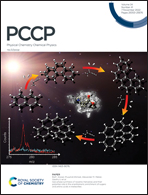Tunability of the electronic properties and electrical contact in graphene/SiH heterostructures†
Abstract
Stacking different two-dimensional materials to generate a vertical heterostructure has been considered a promising way to obtain the desired properties and improve device performance. Here, in this work, using first principles calculations, we design a vertical heterostructure by stacking graphene (GR) and silicane (SiH) and investigate the electronic properties and electrical contact in the GR/SiH heterostructure as well as the possibility of tuning these properties under an external electric field and vertical strain. The GR/SiH heterostructure is structurally and mechanically stable at the equilibrium interlayer separation. The GR/SiH heterostructure exhibits a p-type Schottky contact with a small Schottky barrier of 0.43 eV, presenting great tunability of the electrical contact from Schottky to Ohmic contact under different conditions. The external electric field not only leads to a transition from the p-type to n-type Schottky contact but also induces a transformation from a Schottky contact to Ohmic one. Furthermore, changing the interlayer separation can be considered a useful tool to regulate the Schottky barriers and electric contact in the GR/SiH heterostructure, which is prominent for constructing electronic devices. Our findings could provide an effective tool for the design of high-performance nanoelectronic devices based on the GR/SiH heterostructure.

- This article is part of the themed collection: 2022 PCCP HOT Articles


 Please wait while we load your content...
Please wait while we load your content...